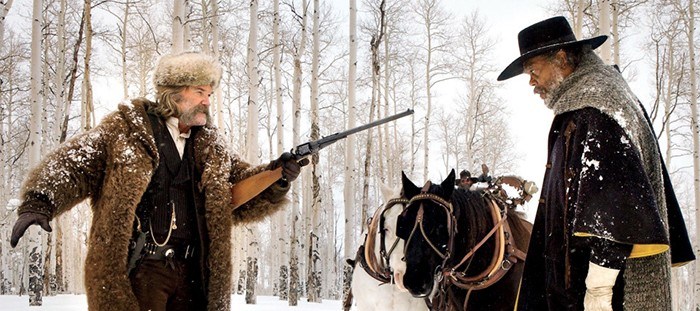It’s not actually film that you’re watching when you go to the movies these days. What you’re seeing on the screen is a digital image created on digital cameras, and while the term “film” has stuck around, the transparent plastic coated with gelatin emulsion and light sensitive silver halide (that was once an industry standard) has become increasingly scarce. And while the pros of digital are certainly persuasive, there are more than a few filmmakers who prefer to work with their medium in its more traditional format; so much so that this sect of filmmakers reversed Kodak’s decision to cease production of actual film last year.
If ever there was an advocate for traditional filmmaking, Quentin Tarantino, director of “The Hateful Eight,” is among the most outspoken. Tarantino shot his recent release not just on film, but on massive 70mm film (double the usual standard, 35mm), also known as “panoramic” film. Remember the last time you decided to see an IMAX film? And the screen was enormous? And curved? That’s because IMAX films are shot exclusively on 70mm. It’s so large that peripheral sight is included in the shot, necessitating the curved screen. As exciting as that is, not every theatre (and by “not every,” I mean “hardly any”) is equipped to play films in 70mm, which requires a massive projector as well as the curved screen.
Fortunately for Portlanders, we have a theatre that proudly exhibits 70mm film: The Hollywood Theater on NE Sandy Blvd, which showed Tarantino’s most recent cinematic endeavor, and even hosted a surprise appearance from the director during opening week.
 When I heard that The Hollywood Theater would be showing “The Hateful Eight” in 70mm, the film geek in me flipped out (and was subsequently enraged that I missed the chance to see Tarantino) and I made plans for a pilgrimage to the east-side theater.
When I heard that The Hollywood Theater would be showing “The Hateful Eight” in 70mm, the film geek in me flipped out (and was subsequently enraged that I missed the chance to see Tarantino) and I made plans for a pilgrimage to the east-side theater.
The showing I attended was completely sold out on a Tuesday night, and the excitement around not just the film, but the format it was being shown in, was tangible in both the staff and crowd. The 70mm showing also included an overture and intermission (which broke up the otherwise 3-hour film wonderfully, with a chance to use the bathroom, and talk about the film midway with friends) making the experience even more unique.
Theatrical experiences aside, “The Hateful Eight” is an honorable addition to Tarantino’s canon. The gritty, slow-paced western finds Tarantino’s typical strong suit in dialogue and editing, which are as creatively aggressive and vulgar as has come to be expected of Tarantino Productions. While those elements are strong and feel particularly refreshing, especially in contrast to the slew of films that have come out in an age wrought with prequels, sequels, and franchise superheros,when compared to other Tarantino films, it is hardly his strongest. The most interesting dialogue hinges on the racial tension between Major Marquis Warren (Samuel L. Jackson) and the rest of the cast, with race relations being a central theme to the film. While this is nothing new for director and screenwriter Tarantino, who was heavily criticized by Spike Lee and others for his liberal use of the n-word in his 2012 film, “Django Unchained,” the theme of racial tension never seems to get past the fact that it exists and can lead to violent and ugly ends. Or in other words, there is a disappointing lack of depth on the subject.
“The Hateful Eight” also employs a much simpler plot than the grandiose narratives of Tarantino’s other works; “Pulp FIction” and “Inglourious Basterds,” for example, are elaborate with various subplots and moving parts that add to the overall charm and splendor of the film. Comparatively “The Hateful Eight” is fairly straight-forward and focuses more on character, character relations, and ideology than plot elements. The entire film takes place in two settings: a cabin in Wyoming, and a carriage that is headed to said cabin. The minimalist approach isn’t new to Tarantino, he did the same thing in his 1992 film “Reservoir Dogs,” and the simplistic setting also stands in contrast to the elaborate CGI worlds that so often occupy films in recent months.
A common criticism expressed about the film is that its pacing is too slow. In a scathing review from The Atlantic ,Christopher Orr complains that “[t]he plot…is dull, plodding, and repetitive: in the hands of a less serious auteur it could have been knocked off in a slender 90 minutes or less.” While it is true that the pacing is certainly slow, this element adds to the plot and overall tenseness of the film as it reaches its gory climax. The slow pacing also allows for gorgeous shots of snow-covered Wyoming in the dead of winter. The pacing feels refreshing, even thoughtful, especially in the cinematic climate of frantic, constant, action sequences that we find ourselves in. That’s not to say that “The Hateful Eight” shies away from violence, to the contrary the second half of the film is drenched in blood, which makes for a wonderful contrast against the first half.
“The Hateful Eight” is a fine addition to Tarantino’s work. It’s not his strongest film, and it doesn’t quite address a lot of the social issues it hints at to satisfactory depth, but it’s still a satisfying film. If you can see it in 70mm, the experience is more than worth it.
“The Hateful Eight” is now in theaters. It was directed and written by Quentin Tarantino and stars: Samuel L. Jackson, Kurt Russell, Jennifer Jason Leigh, and Walton Goggins. “The Hateful Eight” is rated R.





